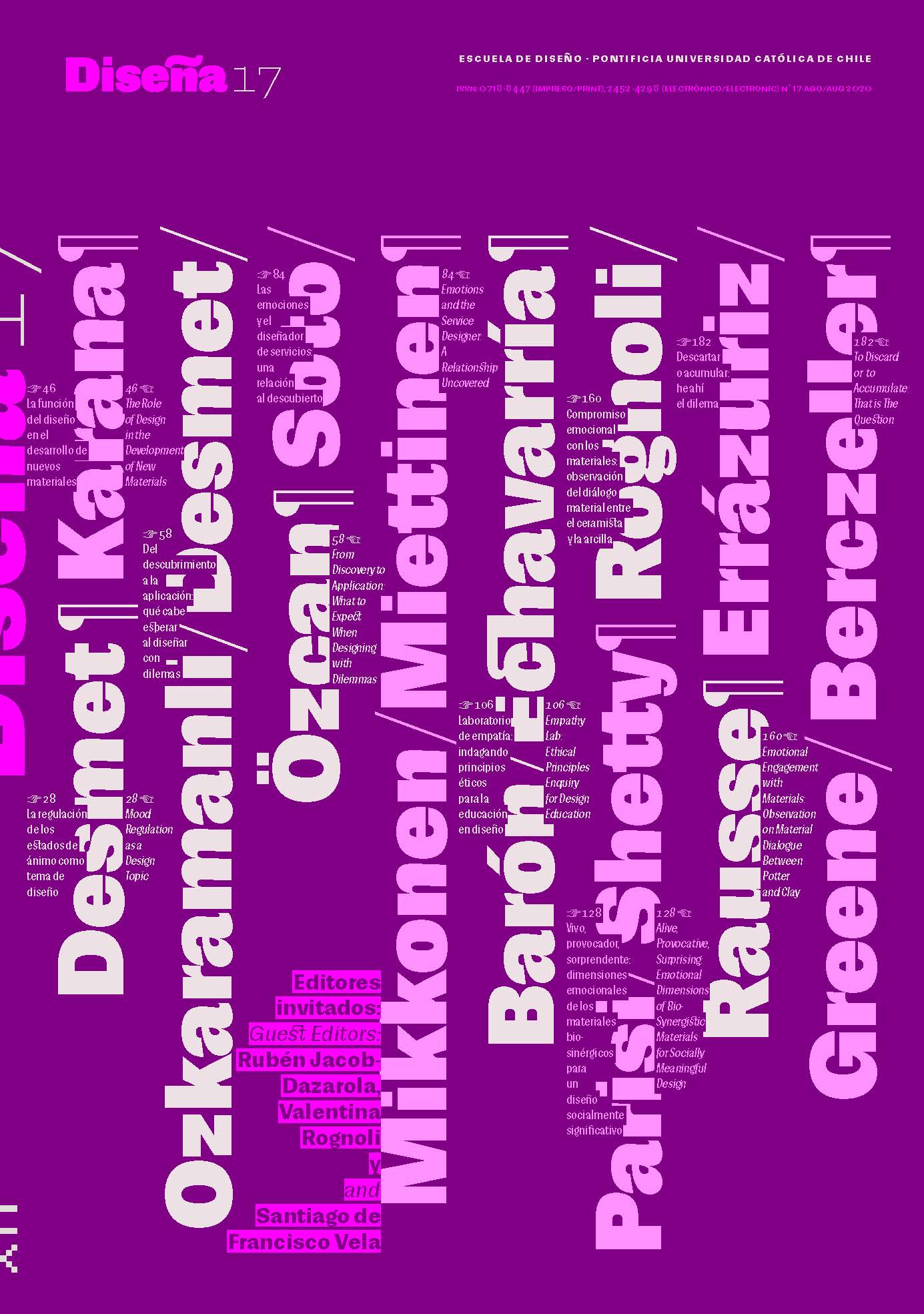Emotions and the Service Designer: A Relationship Uncovered
Main Article Content
Abstract
Emotions are present throughout the service design process for each participant, yet the own emotional experience of designers has rarely been addressed in design research. This paper is focused on the role and meaning of the emotions identified by service designers in their own experiences conducting or participating in projects, and as workshop facilitators. It builds empirically on a qualitative questionnaire examining their experiences of ‒ and reflections on ‒ the emotions they identified throughout their practices. The findings indicate a significant variety of emotions and confusion in determining their connection to the overall process. A clear understanding of the emotions associated with this process could strengthen service designers’ specific skills, enhancing confidence in decision-making, and adding value to their work. This, in turn, could help service designers to improve their professional performance in order to create a more inclusive and user-centered design practice in the context of changing scenarios, variable environments, and human interactions.
Downloads
Article Details

This work is licensed under a Creative Commons Attribution-ShareAlike 4.0 International license.
COPYRIGHT NOTICE
All contents of this electronic edition are distributed under the Creative Commons license of "Attribution-ShareAlike 4.0 Internacional" (CC-BY-SA). Any total or partial reproduction of the material must mention its origin.
The rights of the published images belong to their authors, who grant to Diseña the license for its use. The management of the permits and the authorization of the publication of the images (or of any material) that contains copyright and its consequent rights of reproduction in this publication is the sole responsibility of the authors of the articles.
References
BLOCH, S. (2008). Surfeando la ola emocional. Uqbar Editores.
BOHM, D. (2014). On Dialogue. Routledge.
CSIKSZENTMIHALYI, M. (1990). Flow. Harper Collins.
CUREDALE, R. A. (2013). Service Design: 250 Essential Methods. Design Community College.
DESIGN COUNCIL. (2005). Eleven Lessons: Managing Design in Eleven Global Brands. A study of the Design Process. https://www.designcouncil.org.uk/sites/default/files/asset/document/ElevenLessons_Design_Council%20(2).pdf
DESMET, P. M. A. (2002). Designing Emotions. Delft University of Technology.
DOETSCH-KIDDER, S. (2012). Social Change and Intersectional Activism: The Spirit of Social Movement. Palgrave Macmillan US. https://doi.org/10.1057/9781137100979
EKMAN, P. (1971). Universals and Cultural Differences in Facial Expressions of Emotions. In J. K. Cole (Ed.), Nebraska Symposium on Motivation 1971 (Vol. 19, pp. 207–283). University of Nebraska Press.
EKMAN, P. (2004). Emotions Revealed: Understanding Faces and Feelings. Phoenix.
FRIJDA, N. H. (1986). The Emotions. Cambridge University Press.
FRIJDA, N. H. (1988). The Laws of Emotion. The American Psychologist, 43(5), 349–358. https://doi.org/10.1037//0003-066x.43.5.349
GEORGE, J. M., & DANE, E. (2016). Affect, Emotion, and Decision Making. Organizational Behavior and Human Decision Processes, 136, 47–55. https://doi.org/10.1016/j.obhdp.2016.06.004
HEKKERT, P., & MCDONAGH, D. (2003). Design and Emotion. The Design Journal, 6(2), 1–3. https://doi.org/10.2752/146069203789355453
HOOKS, BELL. (2003). Teaching Community: A Pedagogy of Hope. Routledge.
IZARD, C. E. (2009). Emotion Theory and Research: Highlights, Unanswered Questions, and Emerging Issues. Annual Review of Psychology, 60(1), 1–25. https://doi.org/10.1146/annurev.psych.60.110707.163539
KUURE, E., MIETTINEN, S., & ALHONSUO, M. (2014). Change through Service Design – Service Prototyping as a Tool for Learning and Transformation. In Y. Lim, K. Niedderer, J. Redström, E. Stolterman, & A. Valtonen (Eds.), Proceedings of DRS 2014: Design’s Big Debate (Vol. 1, pp. 469–482). Umeå Institute of Design.
LEAVY, P. (2017). Research Design: Quantitative, Qualitative, Mixed Methods, Arts-Based, and Community-Based Participatory Research Approaches. The Guilford Press.
LERNER, J. S., LI, Y., VALDESOLO, P., & KASSAM, K. S. (2015). Emotion and Decision Making. Annual Review of Psychology, 66(1), 799–823. https://doi.org/10.1146/annurev-psych-010213-115043
MATTELMÄKI, T., VAAJAKALLIO, K., & KOSKINEN, I. (2014). What Happened to Empathic Design? Design Issues, 30(1), 67–77. https://doi.org/10.1162/DESI_a_00249
MIETTINEN, S. (Ed.). (2017). An Introduction to Industrial Service Design. Routledge. https://doi.org/10.4324/9781315566863
MIETTINEN, S., & SARANTOU, M. (2019). Managing Complexity and Creating Innovation through Design. Routledge.
MIKKONEN, E. (2017). Bridges over the Mountain Ranges: Ethnography on the Complexities of Transition in Women’s Social Position in Nepalese Rural Communities [Doctoral Dissertation, Lapland University]. https://www.ulapland.fi/news/Bridges-over-the-Mountain-Ranges-Ethnography-on-the-Complexities-of-Transition-in-Women’s-Social-Position-in-Nepalese-Rural-Communities/jbtleocy/9981802a-d361-4c52-8c93-7bdd1f5118a4
NORMAN, D. (2004). Emotional Design: Why we Love (or Hate) Everyday Things. Basic Books.
PAN, S., SARANTOU, M., & MIETTINEN, S. (2019). Design for Care: How the “Good Old Days” can Empower Senior Residents to Achieve Better Services in an Aged-Care Institution. The International Journal of Design in Society, 13(2), 25–40. https://doi.org/10.18848/2325-1328/CGP/v13i02/25-40
PLUTCHIK, R. (1980). Emotion: A Psychoevolutionary Synthesis. Harper & Row.
POLAINE, A., LØVLIE, L., & REASON, B. (2013). Service Design: From Insight to Inspiration. Rosenfeld Media.
RIVANO ECKERDAL, J., & HAGSTRÖM, C. (2017). Qualitative Questionnaires as a Method for Information Studies Research. Information Research, 22(1), CoLIS paper 1639. http://informationr.net/ir/22-1/colis/colis1639.html
SANDERS, E. B.-N., & STAPPERS, P. J. (2008). Co-creation and the New Landscapes of Design. CoDesign, 4(1), 5–18. https://doi.org/10.1080/15710880701875068
SANGIORGI, D., & PRENDIVILLE, A. (Eds.). (2017). Designing for Service: Key Issues and New Directions. Bloomsbury Academic.
SOTO, M., BEAULÉ, C., ALHONSUO, M., & MIETTINEN, S. (in press). Emotions: The Invisible Aspect of Co-creation Workshops. In Proceedings of the 6th International Conference on Design Creativity (ICDC 2020). University of Oulu, Finland.
STICKDORN, M., HORMESS, M. E., LAWRENCE, A., & SCHNEIDER, J. (2018). This is Service Design Doing: Applying Service Design Thinking in the Real World. O’Reilly.
STICKDORN, M., & SCHNEIDER, J. (2011). This is Service Design Thinking: Basics, Tools, Cases. Wiley.
THALER, R. H., & SUNSTEIN, C. R. (2009). Nudge: Improving Decisions About Health, Wealth, and Happiness. Penguin Books.
TOLOSA, M. R. (2008). A Twist in Communication the Power of the Oasis (SSRN Scholarly Paper ID 1310227). Social Science Research Network. https://doi.org/10.2139/ssrn.1310227
TOLOSA, M. R. (2013). Communities and Social Network, the Collapse of Pyramids. Papyrbit.

